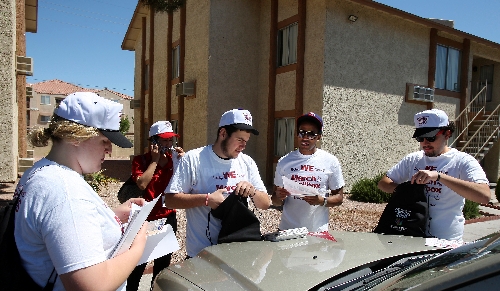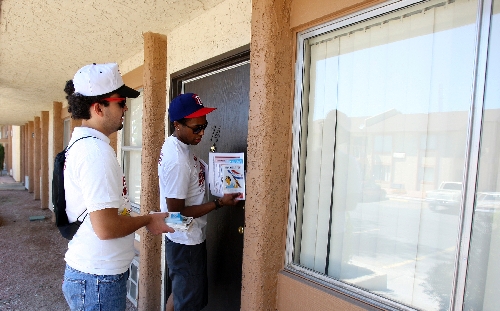Students let people know they count
Mallory Cyr scooted around a baby stroller left on the front porch of an apartment Friday morning. The front door was open.
A Hispanic woman peeked out the door with an inquisitive look on her face.
Cyr, a University of Nevada, Las Vegas student, started to tell the woman why she was there.
"I'm sorry," the woman said. "Don't speak English."
So Cyr, a women's studies and English education major, switched languages. She told the woman that workers from the U.S. Census Bureau would soon be coming around. Cyr said there was nothing to be afraid of. That these workers would ask a few easy questions.
She handed the woman some printed information before an older woman approached from inside the apartment. Cyr repeated part of what she'd said already.
The older woman told her they filled out their census forms and mailed them in.
A smile spread across Cyr's face.
"Oh," she said. "No problema."
She moved to the next building in the sprawling, low-income complex. Only 25,999 people left to go.
Cyr and a couple dozen other UNLV students fanned out last week and did what college kids have been doing for decades: They pasted their idealism to their chests and set about to help people.
This particular group of students joined forces with the U.S. Census Bureau to help people understand how important the bureau's work is.
Right now, census workers are going across the country to count how many people are in the United States. They do this every 10 years, as is specified in the Constitution. How many people live in which areas helps determine things such as how many representatives in Congress each state gets and which particular areas they're going to represent.
The distribution of the population is also critically important to figuring out how to dole out federal money for the next decade. Census folks say for every person not counted in Nevada, the state will lose $917 in federal money every year for a decade.
Traditionally, minorities and the poor have a lower response rate to the Census Bureau's initial counting method: a mail-in form. Statewide, for example, Nevada had an estimated response rate of 69 percent. That means a little more than two thirds of Nevadans mailed in their forms as they were supposed to.
But the area near UNLV -- between Maryland Parkway, Eastern Avenue, Tropicana Avenue and Karen Avenue -- didn't do so well. David Byerman , the chief government liaison for Nevada from the Census Bureau, said the census tracts in that area had response rates between 48 percent and 60 percent.
It's largely a minority area, full of cheap apartments and aging strip malls. The Bureau estimates 26,000 people live in that area.
The idea for Friday's project came from two students. Juan Serafica and Sergio Orgel had a class together not so long ago. It was called Leadership and Social Change. The point of the class, these guys said, was to get the students thinking about community involvement. The whole one-man-can-make-a-difference stuff.
So that's what they did, they got to thinking.
How can we make a difference?
They knew about the census that was going on, of course. And they'd heard about the poor participation rate in low-income neighborhoods. So they started going to meetings of the Southern Nevada Asian Pacific Coalition for Census, an advocacy group that tries to get minorities to participate in the census.
Serafica, by the way, is chairman of a campus group called Raising Our Asian Rights, or ROAR. Orgel is a member of the Nu Alpha Kappa fraternity, which caters to Latinos.
The two guys organized the event on Friday. They reached out to friends and groups on campus that are active in minority issues.
Their goal was to tell people in the surrounding neighborhoods that they had nothing to fear from the census workers. The students told the residents that they should expect census workers to come knocking on their doors soon if they hadn't filled out their forms.
They handed out fliers in several languages. They answered questions. They gave little kids boxes of colored pencils.
They hoped what they were doing would help.
Contact reporter Richard Lake at rlake@review journal.com or 702-383-0307.


















